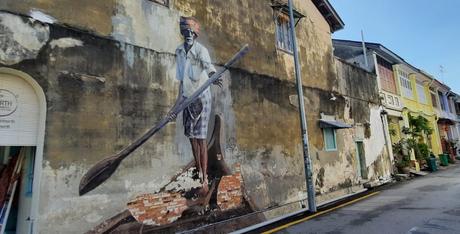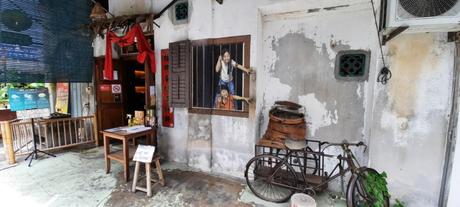
Spending a day or two soaking in the colonial charm and beauty of George Town is the best way to discover this UNESCO World Heritage site. Visitors will be certainly mesmerized by the vivid and colorful murals and will be tempted by the delicious local foods. However, its character and heritage lie in its diversity of neighborhoods - one should also spend time wandering these streets.
Once a free port under British rule, George Town was at its glorious peak in the 18 th and 19 th century. International merchants and traders flocked to this harbor city for business and built a thriving and diverse community. Almost every street in George Town is rich in history and hides a fascinating past.
When the darkness of the night falls and street lights flicker to life, haunting and beautiful old songs begin playing on an old record player. It is this special time that the streets exude an eerily nostalgic atmosphere; it is so intense visitors can clearly feel it under their skin - a time warp and connection to days long ago.
At the stroke of midnight, it seems like the old historic buildings begin peeling off their old façade, bit by bit, reversing their visual appearance to their former glory. Ghosts of bygone days wander through the thick mists - partly translucent and seemingly harmless, they beckon you over to join them for a walk down memory lane.

Armenian Street:
This was once home to early Armenian merchants. The population, however, started to thin out after the century old Armenian church was demolished. Later, the street was known for its Chinese and Malay secret societies - Kien Tek Kongsi, Red Flag and White Flag. It was also famous for copper and brass products.
With the church torn away
Settlers bid farewell and sail away
When the dusk sets in
The sound of making copper is still ringing
Mixing with the clamor of the Chinese and Malay secret societies
Echoing in the passage of eternity

Cannon Street:
The street witnessed bloodshed stemming from a riot in 1867. The pandemonium escalated to a point when the government fired a cannon into a shelter where Kien Teik society members were taking refuge.
When the riot boils to a climax
The cannon booms and blasts
Reduce the rogue's refuge to a gust of dust
Argus Lane:
The area was once a Catholic Eurasian Village with the Church of the Assumption as the focal point. The church community was also known as "Serani", referring to Christians and by extension to Eurasian. The street name commemorates Penang's first independent newspaper - Pinang Argus which came into existence from 1867 to 1873.
A community of Eurasians converges in unison
They live by the name "Serani"
Their heritage and culture live on in harmony
"Pinang Argus" will always be remembered
Its flame of legacy is burning in Argus Lane forever
Market Lane:
The street is named after the nearby market. Many buildings in this area were owned by wealthy men to shelter their concubines, an accepted social norm in the days of yore.
The chatter from lovebirds never cease to quit
Wealthy men walk out the door in a mood for love
Concubines say their goodbye through the window in great thirst
Their hearts and desires are a cup half full
For they hope the next romance will be at the same rendezvous
German Heritage Trail:
The trail was named in memory of August Huttenbach, a German who formed Huttenbach Brothers & Co in 1885 with his brother, Louis. The company contributed to technological modernization in Penang -for instance in 1874, petroleum lamps were introduced by the company to light up the streets. Huttenbach was appointed as Legislative Councilor in 1894 for his efforts in breathing new life into the city,
Waiting for petroleum lamp to work its magic
The first flick of light illuminates the darkness
Applause across the city rings out the loudest
Huttenbach stands by a lamp post, smiles in pride
His tall silhouette on the wall, will never be swallowed by the night

Rope Walk:
The scene of people weaving ropes made of coconut husk fibers was common here. The ropes were then delivered to the port by hand carts and bullock carts. These ropes were used to tie ships to a pier.
Braid, knot and loop, the workers never rest even for a bit
The wages they make barely put food on the table
Just like the fleet need the ropes to keep them together
At the crack of dawn, the voice of Cat Stevens tenderly wakes one up and brings one back to reality. No more ghosts linger, and the buildings are still heavily marked by the passage of time, creating a lilting contrast with the surrounding modern architecture.
"Morning has broken like the first morningBlackbird has spoken like the first bird
Praise for the singing, praise for the morning
Praise for them springing fresh from the world"
The moment you open your eyes to the early morning sun, you may suspect your surreal experiences from the night are only a delusion, a pleasant dream or a fantasy - however one thing is certain; you are already falling in love with this island city.

